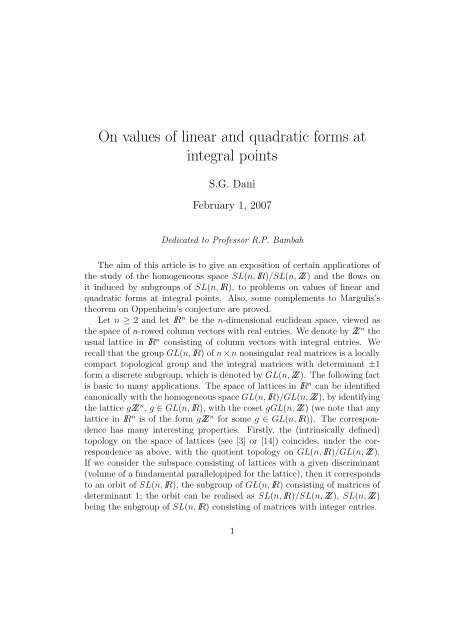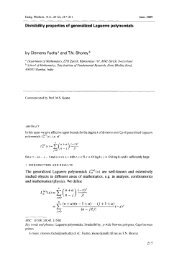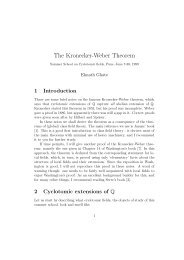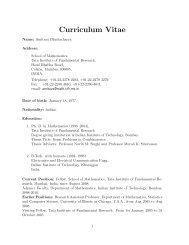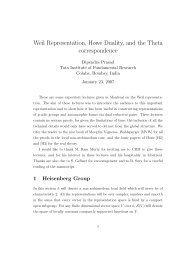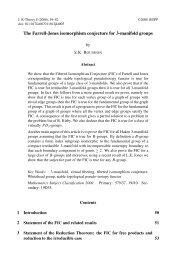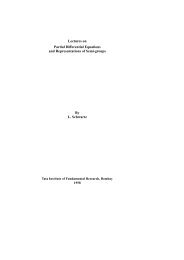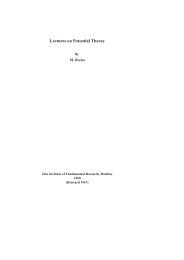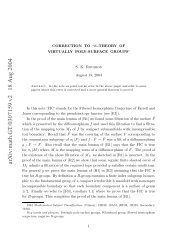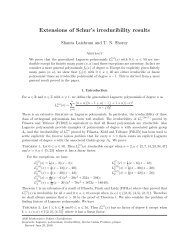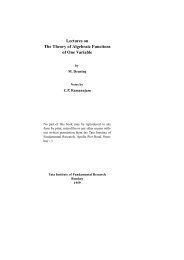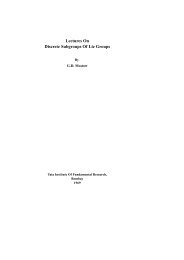On values of linear and quadratic forms at integral points
On values of linear and quadratic forms at integral points
On values of linear and quadratic forms at integral points
Create successful ePaper yourself
Turn your PDF publications into a flip-book with our unique Google optimized e-Paper software.
Let N be the subgroup <strong>of</strong> SL(n, IR) consisting <strong>of</strong> all upper triangular m<strong>at</strong>riceswith 1’s on the diagonal <strong>and</strong> for any τ > 0 let N τ denote the subset<strong>of</strong> N consisting <strong>of</strong> all those m<strong>at</strong>rices for which every <strong>of</strong>f-diagonal entryis <strong>of</strong> absolute value <strong>at</strong> most τ. Also let K denote the subgroup <strong>of</strong>SL(n, IR) consisting <strong>of</strong> orthogonal m<strong>at</strong>rices <strong>of</strong> determinant 1. A set <strong>of</strong> theform KD σ N τ = {kdu | k ∈ K, d ∈ D σ , u ∈ N τ } is called a Siegel set. Itcan be verified th<strong>at</strong> any Siegel set is <strong>of</strong> finite Haar measure in SL(n, IR). Itis a crucial fact th<strong>at</strong> for suitable <strong>values</strong> <strong>of</strong> σ <strong>and</strong> τ the corresponding Siegelset is a fundamental domain for SL(n, Z) in SL(n, IR), namely we have thefollowing.Theorem 2.1 (cf. [21], Ch. X). Let F = KD 2/√3N 1/2 . ThenSL(n, IR) = F (SL(n, Z)).Concerning l<strong>at</strong>tice <strong>points</strong> this implies th<strong>at</strong> if e 1 is the column vector inwhich the first row entry is 1 <strong>and</strong> the others are 0 then the set F e 1 = {ge 1 |g ∈ F } contains a nonzero point <strong>of</strong> any l<strong>at</strong>tice Λ ∈ L 1 ; (though the argumentcould be applied to other <strong>integral</strong> <strong>points</strong> in the place <strong>of</strong> e 1 , it does not lead toany useful inform<strong>at</strong>ion when the point is not a multiple <strong>of</strong> e 1 ). Now, F e 1 canbe seen to be the complement <strong>of</strong> {0} in the closed ball <strong>of</strong> radius (4/3) n−14 ,namely the maximum possible value for the first entry <strong>of</strong> any element <strong>of</strong>D√2/ 3. This establishes the result <strong>of</strong> Hermite mentioned earlier, th<strong>at</strong> a ballcentered <strong>at</strong> 0 contains a nonzero point <strong>of</strong> any l<strong>at</strong>tice from L 1 if its radiusexceeds (4/3) n−14 ; for a closed ball conclusion holds for radius (4/3) n−14 aswell. Since any positive definite <strong>quadr<strong>at</strong>ic</strong> form Q on IR n is equivalent tothe <strong>quadr<strong>at</strong>ic</strong> form Q 0 given by the square <strong>of</strong> the usual norm (namely thereexists a g ∈ GL(n, IR) such th<strong>at</strong> Q(v) = Q 0 (gv) for all v ∈ IR n ) this impliesthe following.Corollary 2.2. Let Q be a positive definite <strong>quadr<strong>at</strong>ic</strong> form on IR n . Thenthere exists x ∈ Z n such th<strong>at</strong> Q(x) ≤ (4/3) (n−1)/2 d(Q) 1/n , where d(Q) denotesthe discriminant <strong>of</strong> Q.3 A theorem <strong>of</strong> Howe <strong>and</strong> MooreIn this section we recall a theorem <strong>of</strong> Howe <strong>and</strong> Moore, specialised to the case<strong>of</strong> the homogeneous space SL(n, IR)/SL(n, Z), <strong>and</strong> discuss its implic<strong>at</strong>ions4
to l<strong>at</strong>tices in IR n . As before we shall denote by m the normalised SL(n, IR)-invariant measure on L 1 = SL(n, IR)/SL(n, Z).Theorem 3.1 (Howe <strong>and</strong> Moore; see [15]). Let {g i } be a divergentsequence in SL(n, IR) (namely with no limit point in SL(n, IR)). Then forany square-integrable functions f <strong>and</strong> φ on L 1 we have∫f(g i x)φ(x) dm →L 1∫f dmL 1 ∫φ dm,L 1 as i → ∞.This implies the following corollary; it may be mentioned here th<strong>at</strong> thecorollary generalises a theorem proved in a number-theoretic context byW.M. Schmidt, (see [23]); the result <strong>of</strong> Schmidt is the particular case <strong>of</strong> thecorollary when the sequence {g i } is chosen to be {diag (i, i, . . . , i, i −n+1 )}.Corollary 3.2. Let {g i } be a divergent sequence in SL(n, IR). Then foralmost every l<strong>at</strong>tice Λ ∈ L 1 the set <strong>of</strong> l<strong>at</strong>tices {g i Λ} is dense in L 1 .For convenience we shall include here a pro<strong>of</strong> <strong>of</strong> the corollary. Beforegoing over to the pro<strong>of</strong> let me however note the following. In the corollary‘almost every’ is meant in the sense th<strong>at</strong> the set <strong>of</strong> l<strong>at</strong>tices Λ ∈ L 1 for whichthe st<strong>at</strong>ement does not hold (for a given sequence {g i } as in the hypothesis)is a set <strong>of</strong> m-measure 0, where m is the SL(n, IR)-invariant measure on L 1 .In the set <strong>of</strong> all l<strong>at</strong>tices (not only from L 1 ) one can also interpret ‘almostevery’ to mean a l<strong>at</strong>tice gener<strong>at</strong>ed by n <strong>linear</strong>ly independent vectors v 1 , . . . , v nwhich may be chosen from a set <strong>of</strong> full Lebesgue measure. It can be seenth<strong>at</strong> the corollary means also th<strong>at</strong> for almost every l<strong>at</strong>tice Λ in this sense{g i Λ} is dense in the set <strong>of</strong> l<strong>at</strong>tices whose discriminant coincides with th<strong>at</strong><strong>of</strong> Λ (we shall however not go into the details <strong>of</strong> this).Pro<strong>of</strong> <strong>of</strong> the Corollary: Firstly we observe th<strong>at</strong> as a consequence <strong>of</strong> the theorem,for any measurable subset E <strong>of</strong> L 1 such th<strong>at</strong> m(E) > 0 we havem( ⋃ i g−1 i (E)) = 1; for if E is such a set <strong>and</strong> f <strong>and</strong> φ are the characteristicfunctions <strong>of</strong> E <strong>and</strong> ⋃ i g−1 i (E) respectively then we have f(g i x)φ(x) =f(g i x) for all x ∈ L 1 , for all i. Hence by the theorem ( ∫ f dm)( ∫ ∫φ dm) =f(gi x) dm(x) = ∫ f dm <strong>and</strong> since ∫ f dm = m(E) > 0 this implies th<strong>at</strong>m( ⋃ i g−1 i (E)) = ∫ φ dm = 1, as claimed. Now let {Ω j } ∞ j=1 be a countablebasis for the topology <strong>of</strong> L 1 . Then for all j we have m(Ω j ) > 0 <strong>and</strong> hencem( ⋃ i g−1 i (Ω j )) = 1. Put Y = ⋂ j⋃i g−1 i (Ω j ). Then m(Y ) = 1 <strong>and</strong> for anyΛ ∈ Y , {g i Λ} is dense in L 1 .5
The corollary implies in particular th<strong>at</strong> for any closed noncompact subgroupH <strong>of</strong> SL(n, IR), for almost all Λ ∈ L 1 the H-orbit <strong>of</strong> Λ is dense inL 1 . The theorem <strong>of</strong> Howe <strong>and</strong> Moore implies further th<strong>at</strong> for such an H ameasurable function f on L 1 is H-invariant (i.e. f(hΛ) = f(Λ) for all h ∈ H)if <strong>and</strong> only if it is constant almost everywhere. In particular all H-invariantmeasurable sets are <strong>of</strong> measure 0 or 1, namely the action is ‘ergodic’.4 Duality <strong>and</strong> <strong>values</strong> <strong>of</strong> <strong>linear</strong> <strong>forms</strong>Let H be a closed noncompact subgroup <strong>of</strong> SL(n, IR) <strong>and</strong> consider the action<strong>of</strong> SL(n, IR) on the quotient space SL(n, IR)/H. By restriction we get anaction <strong>of</strong> SL(n, Z) on SL(n, IR)/H. We note th<strong>at</strong> for a g ∈ SL(n, IR)the H-orbit <strong>of</strong> gSL(n, Z) is dense in SL(n, IR)/SL(n, Z) if <strong>and</strong> only if theSL(n, Z)-orbit <strong>of</strong> g −1 H is dense in SL(n, IR)/H, as either <strong>of</strong> them holdsif <strong>and</strong> only if HgSL(n, Z) is a dense subset <strong>of</strong> SL(n, IR). Since almost allH-orbits are dense (as seen in the previous section) it follows th<strong>at</strong> almost allorbits <strong>of</strong> SL(n, Z) are dense in SL(n, IR)/H.The correspondence as above, known as duality, can be used together withresults above orbits <strong>of</strong> subgroups H <strong>of</strong> SL(n, IR) on SL(n, IR)/SL(n, Z) todeduce results about orbits <strong>of</strong> SL(n, Z) under various <strong>linear</strong> actions whichare <strong>of</strong> significance in terms <strong>of</strong> Diophantine approxim<strong>at</strong>ion. For many subgroups,especially those gener<strong>at</strong>ed by unipotent elements, the closure <strong>of</strong> orbitsis well-understood, thanks to the work <strong>of</strong> M. R<strong>at</strong>ner on Raghun<strong>at</strong>han’sconjecture (see [22] <strong>and</strong> [7] for details). For the so called horospherical subgroupsthe Raghun<strong>at</strong>han conjecture was proved earlier. We next recall someresults on <strong>values</strong> <strong>of</strong> <strong>linear</strong> <strong>forms</strong> which follows from the orbit behaviour <strong>of</strong>the horospherical subgroups.For 1 ≤ p ≤ (n−1) let E p denote the p-fold Cartesian product IR n ×· · ·×IR n . An element (v 1 , . . . , v p ) ∈ E p is called a Euclidean p-frame if v 1 , . . . , v pare <strong>linear</strong>ly independent. For f = (v 1 , . . . , v p ) ∈ E p we shall denote by 〈f〉the subspace <strong>of</strong> IR n spanned by {v 1 , . . . , v p }. The duality argument as aboveimplies in particular the following result, first proved in [11].Theorem 4.1 (cf. [11]). Consider the action <strong>of</strong> SL(n, Z) on E p given bythe componentwise action on each copy <strong>of</strong> IR n . Let f = (v 1 , . . . , v p ) be aEuclidean p-frame. Then the SL(n, Z) orbit <strong>of</strong> f is dense in E p if <strong>and</strong> onlyif 〈f〉 contains no nonzero <strong>integral</strong> vector (namely, 〈f〉 ∩ Z n = (0)).6
More generally, if x 1 , . . . , x q ∈ Z n , q ≥ 1, are such th<strong>at</strong>〈(v 1 , . . . v p , x 1 , . . . , x q )〉 ∩ Z n ⊆ 〈(x 1 , . . . , x q )〉,(when x i ’s are 0 we get the special case as above) <strong>and</strong> Γ is the subgroup{γ ∈ SL(n, Z) | γ(x j ) = x j for all j = 1, . . . q}, then the Γ-orbit <strong>of</strong> f isdense in E p .The second assertion in the theorem follows from the pro<strong>of</strong> <strong>of</strong> Proposition4.3 in [11]; in the st<strong>at</strong>ement <strong>of</strong> the proposition there, the conclusion asabove is claimed under a weaker hypothesis, which however is incorrect.Theorem 4.1 can be interpreted as a result on <strong>values</strong> <strong>of</strong> <strong>linear</strong> <strong>forms</strong> <strong>at</strong><strong>integral</strong> <strong>forms</strong>, by viewing each vector in IR n as the coefficients <strong>of</strong> a <strong>linear</strong>form. Let F n denote the space <strong>of</strong> <strong>linear</strong> <strong>forms</strong> on IR n , namely the dual space.We consider the action <strong>of</strong> SL(n, Z) on F n given by (γ, L) ↦→ L ◦ γ −1 for allγ ∈ SL(n, Z) <strong>and</strong> L ∈ F n (the so called contragradient action). Via theduality <strong>of</strong> F n <strong>and</strong> IR n as vector spaces the theorem implies the following:Corollary 4.2. Let L 1 , . . . , L p be <strong>linear</strong> <strong>forms</strong> on IR n , where 1 ≤ p ≤ n − 1.Let M 1 , . . . M q , q ≥ 0, be r<strong>at</strong>ional <strong>linear</strong> <strong>forms</strong> on IR n such th<strong>at</strong> a <strong>linear</strong>combin<strong>at</strong>ion <strong>of</strong> the form Σ p i=1 λ iL i + Σ q j=1 µ jM j , where λ i ’s <strong>and</strong> µ j ’s are realnumbers, is not a r<strong>at</strong>ional form unless λ i = 0 for all i. Then{(L 1 ◦ γ, . . . , L p ◦ γ) | γ ∈ SL(n, Z), M j ◦ γ = M j for all j = 1, . . . q}is dense in F n × · · · × F n (p copies). In particular for any t 1 , . . . , t q ∈ IR forwhich there exists x 0 ∈ Z n such th<strong>at</strong> M j (x 0 ) = t j for all j = 1, . . . q, anya 1 , . . . , a p ∈ IR <strong>and</strong> ɛ > 0 there exists x ∈ P( Z n ) such th<strong>at</strong>|L i (x) − a i | < ɛ <strong>and</strong> M j (x) = t j , for all i = 1, . . . , p <strong>and</strong> j = 1, . . . q.Similarly one can also obtain results involving approxim<strong>at</strong>ion <strong>of</strong> vectors<strong>and</strong> <strong>forms</strong> simultaneously. In this respect we note the following (see [4]):Theorem 4.3. Let k, l ∈ {1, . . . , n} be such th<strong>at</strong> k + l ≤ n − 1 <strong>and</strong> let Xdenote the space <strong>of</strong> (k + l)-tuples <strong>of</strong> the form (v 1 , . . . , v k , L 1 , . . . , L l ) wherev i ∈ IR n , L j ∈ F n <strong>and</strong> L j (v i ) = 0 for all i = 1, . . . , k <strong>and</strong> j = 1, . . . , l; (werealise X as a subset <strong>of</strong> IR n × · · · × IR n × F n × · · · × F n , k <strong>and</strong> l copiesrespectively). Consider the SL(n, Z)-action on X, defined componentwise.Then for (v 1 , . . . , v k , L 1 , . . . , L l ) ∈ X the orbit is dense in X if <strong>and</strong> only ifv 1 , . . . v k <strong>and</strong> L 1 , . . . L l are <strong>linear</strong>ly independent in the respective spaces <strong>and</strong>the subspaces spanned by them do not contain any nonzero r<strong>at</strong>ional elements(vector or <strong>linear</strong> form respectively).7
5 The Oppenheim conjectureWe have seen in Section 1 th<strong>at</strong> study <strong>of</strong> the space SL(n, IR)/SL(n, Z) enablesto underst<strong>and</strong> <strong>integral</strong> solutions <strong>of</strong> Diophantine inequalities <strong>of</strong> the formQ(x) < a, where Q is any positive definite <strong>quadr<strong>at</strong>ic</strong> form. Study <strong>of</strong> certainflows on the space is applied to similar questions in respect <strong>of</strong> indefinite<strong>quadr<strong>at</strong>ic</strong> <strong>forms</strong>. In fact in this case the only known complete results arearrived <strong>at</strong> from the study <strong>of</strong> flows on the homogeneous space as above.Let Q be an indefinite <strong>quadr<strong>at</strong>ic</strong> form on IR n . Then the sets <strong>of</strong> the form{v ∈ IR n | 0 < |Q(v)| < a} have infinite volume for every a > 0. In thelight <strong>of</strong> this one may ask whether they all contain nonzero <strong>integral</strong> <strong>points</strong>.For this to hold (for all a > 0) one would have to assume however th<strong>at</strong> Q isnot a multiple <strong>of</strong> a form with r<strong>at</strong>ional coefficients, since otherwise the set <strong>of</strong><strong>values</strong> <strong>of</strong> Q <strong>at</strong> <strong>integral</strong> <strong>points</strong> would be discrete. Even with this additionalcondition the conclusion does not hold for certain <strong>forms</strong> in two variables.It is well-known th<strong>at</strong> there exist numbers λ ∈ IR such th<strong>at</strong> q 2 |λ − p | is qbounded below by a positive number, as p, q vary over integers, q ≠ 0 (theso called badly approximable numbers; see [19], where they are actuallycalled ‘numbers <strong>of</strong> constant type’) <strong>and</strong> this means th<strong>at</strong> for the <strong>quadr<strong>at</strong>ic</strong>form Q(x 1 , x 2 ) = x 2 (λx 2 − x 1 ) there exists a > 0 such th<strong>at</strong> there is no<strong>integral</strong> point x with 0 < |Q(x)| < a. There was a conjecture, origin<strong>at</strong>ingfrom an observ<strong>at</strong>ion by Oppenheim th<strong>at</strong> for n ≥ 3 a nondegener<strong>at</strong>e indefinite<strong>quadr<strong>at</strong>ic</strong> form Q on IR n , the set <strong>of</strong> <strong>values</strong> <strong>at</strong> <strong>integral</strong> <strong>points</strong> is dense in IR,whenever Q is not a scalar multiple <strong>of</strong> a form with integer coefficients. Theconjecture was proved by Margulis in the mid eighties; see [20] for a detailedexposition, including on historical aspects. L<strong>at</strong>er, the following rel<strong>at</strong>ivelystronger assertion was proved in a joint paper <strong>of</strong> Margulis with the presentauthor <strong>and</strong> subsequently an elementary pro<strong>of</strong> <strong>of</strong> the same result was givenin [9]; see also [5] for another elementary pro<strong>of</strong> <strong>and</strong> [6] for an exposition <strong>of</strong>the pro<strong>of</strong> <strong>of</strong> a weaker result.We recall th<strong>at</strong> an element x ∈ Z n is said to be primitive if 1 x is notkcontained in Z n for any integer k ≥ 2. We denote the set <strong>of</strong> all primitive<strong>integral</strong> elements by P( Z n ).Theorem 5.1. Let Q be a nondegener<strong>at</strong>e indefinite <strong>quadr<strong>at</strong>ic</strong> form on IR n ,n ≥ 3, which is not a multiple <strong>of</strong> a form with integer coefficients. ThenQ(P( Z n )) is dense in IR, th<strong>at</strong> is, for any t ∈ IR <strong>and</strong> ɛ > 0 there exists aprimitive <strong>integral</strong> vector x such th<strong>at</strong> |Q(x) − t| < ɛ.8
The argument <strong>of</strong> Margulis <strong>and</strong> th<strong>at</strong> in the subsequent papers referred toabove depends on the study <strong>of</strong> orbits <strong>of</strong> the special orthogonal groups <strong>of</strong> indefinite<strong>quadr<strong>at</strong>ic</strong> <strong>forms</strong>, on SL(n, IR)/SL(n, Z). Let Q be a nondegener<strong>at</strong>eindefinite <strong>quadr<strong>at</strong>ic</strong> form on IR n <strong>and</strong> let H = SO(Q) be the associ<strong>at</strong>ed specialorthogonal group, namely {g ∈ SL(n, IR) | Q(gv) = Q(v) for all v ∈ IR n }.Then H is a closed noncompact subgroup <strong>of</strong> SL(n, IR). Hence Corollary 3.2implies th<strong>at</strong> almost all orbits <strong>of</strong> H on L 1 = SL(n, IR)/SL(n, Z) are dense.In fact we have the following:Theorem 5.2. Let the not<strong>at</strong>ion be as above; in particular, we suppose th<strong>at</strong>n ≥ 3. Then every orbit <strong>of</strong> H on L 1 is either closed or dense.Theorem 5.2 was proved by Margulis <strong>and</strong> the present author for n = 3<strong>and</strong> applied to deduce Theorem 5.1 (for all n ≥ 3). For a general n ≥ 3 it isa consequence <strong>of</strong> a celebr<strong>at</strong>ed theorem <strong>of</strong> M. R<strong>at</strong>ner, proving a conjecture <strong>of</strong>Raghun<strong>at</strong>han (see [22] <strong>and</strong> [7] for some details <strong>and</strong> references). Theorem 5.2also implies the following generalis<strong>at</strong>ion <strong>of</strong> Theorem 5.1, noted by A. Borel<strong>and</strong> G. Prasad [1].Theorem 5.3 (Borel <strong>and</strong> Prasad). Let Q be a nondegener<strong>at</strong>e indefinite<strong>quadr<strong>at</strong>ic</strong> form on IR n , n ≥ 3, which is not a multiple <strong>of</strong> a form with integercoefficients <strong>and</strong> let B be the corresponding bi<strong>linear</strong> form (defined by B(v, w) =14 (Q(v + w) − Q(v − w)) for all v, w ∈ IRn ). Then for any v 1 . . . , v n−1 ∈ IR n<strong>and</strong> ɛ > 0 there exist x 1 , . . . , x n−1 ∈ P( Z n ) such th<strong>at</strong>|B(v i , v j ) − B(x i , x j )| < ɛ, for all i, j = 1, . . . , n − 1.In respect <strong>of</strong> deduction <strong>of</strong> Theorem 5.3 from Theorem 5.2 it may be worthwhileto note the following. Let Q be a nondegener<strong>at</strong>e indefinite <strong>quadr<strong>at</strong>ic</strong>form on IR n . Let Q 0 be a r<strong>at</strong>ional <strong>quadr<strong>at</strong>ic</strong> form <strong>and</strong> let g ∈ SL(n, IR) besuch th<strong>at</strong> for a suitable λ ∈ IR (depending on the discriminants <strong>of</strong> Q <strong>and</strong>Q 0 ), Q(v) = λQ 0 (gv) for all v ∈ IR n ; such Q 0 <strong>and</strong> g exist <strong>and</strong> in fact Q 0can be chosen to be one <strong>of</strong> the st<strong>and</strong>ard <strong>quadr<strong>at</strong>ic</strong> <strong>forms</strong>. Then H-orbit <strong>of</strong>gSL(n, Z) is closed L 1 if <strong>and</strong> only if <strong>and</strong> Q is a multiple <strong>of</strong> a form with integercoefficients (see [9]). In the altern<strong>at</strong>ive case, namely when the orbit isdense, the conclusion as in Theorem 5.3 follows from a continuity argument.It may be mentioned here th<strong>at</strong> Borel <strong>and</strong> Prasad [1] consider also similarproblems in the context <strong>of</strong> nonarchimedian valu<strong>at</strong>ions (in the place <strong>of</strong> theusual absolute value); we shall however not go into the details.9
6 Complements to the Oppenheim conjectureWe shall now discuss analogous questions about <strong>values</strong> <strong>of</strong> <strong>quadr<strong>at</strong>ic</strong> <strong>forms</strong> <strong>at</strong><strong>integral</strong> <strong>points</strong>, in some cases complementary to the results on Oppenheimconjecture.Let us first consider the nondegeneracy condition in the Oppenheim conjecture,as in Theorem 5.1. Though it has been traditional to assume nondegeneracyin the context <strong>of</strong> the problem, unlike in some other problems thegeneral case here does not readily reduce to proving the result in the case<strong>of</strong> nondegener<strong>at</strong>e <strong>forms</strong> (the reader may convince himself <strong>of</strong> this by perusingthe cases arising in the pro<strong>of</strong> <strong>of</strong> Theorem 6.1 below).Let Q be a (possibly degener<strong>at</strong>e) <strong>quadr<strong>at</strong>ic</strong> form. We recall th<strong>at</strong> theradical <strong>of</strong> Q is the subspace W = {w ∈ IR n | Q(v + tw) = Q(v) for all v ∈IR n <strong>and</strong> t ∈ IR}. Suppose th<strong>at</strong> W is a r<strong>at</strong>ional subspace <strong>of</strong> IR n (namely, itis defined by <strong>linear</strong> equ<strong>at</strong>ions with r<strong>at</strong>ional coefficients). Then the image( Z n + W )/W <strong>of</strong> Z n in R n /W is a l<strong>at</strong>tice <strong>and</strong> IR n /W can be realised as IR m ,where m is the codimension <strong>of</strong> W in IR n , with ( Z n + W )/W correspondingto Z m . Hence Q factors to a <strong>quadr<strong>at</strong>ic</strong> form, say Q ′ , on IR m <strong>and</strong> Q( Z n ) =Q ′ ( Z m ). Further, it can be seen th<strong>at</strong> there exists a positive integer r suchth<strong>at</strong> Q ′ (P( Z m )) ⊆ Q(P( Z n ) ⊆ 1 r Q′ (P( Z m ). This shows in particular th<strong>at</strong>if the radical <strong>of</strong> a <strong>quadr<strong>at</strong>ic</strong> form Q is a r<strong>at</strong>ional subspace <strong>of</strong> codimension 2then the study <strong>of</strong> its <strong>values</strong> reduces to the 2-variable case; (see below for adiscussion on the 2-variables case). We now note the following:Theorem 6.1. Let Q be a <strong>quadr<strong>at</strong>ic</strong> form on IR n , n ≥ 3, which is indefinite(th<strong>at</strong> is, there exist v, w ∈ IR n such th<strong>at</strong> Q(v) < 0 < Q(w)) <strong>and</strong> not amultiple <strong>of</strong> a form with r<strong>at</strong>ional coefficients. Then <strong>at</strong> least one <strong>of</strong> the followingconditions holds:i) the radical <strong>of</strong> Q is a r<strong>at</strong>ional subspace <strong>of</strong> codimension 2; orii) Q(P( Z n )) is dense in IR.Pro<strong>of</strong>: If the rank <strong>of</strong> Q is <strong>at</strong> least 3 then the argument as in the pro<strong>of</strong> <strong>of</strong> Theorem1 in [8] (reducing the number <strong>of</strong> variables to 3, in which case Q would benondegener<strong>at</strong>e) shows, together with Theorem 5.1, th<strong>at</strong> condition (ii) holds.Note th<strong>at</strong> since the form is indefinite, the rank is <strong>at</strong> least 2. Now supposeth<strong>at</strong> Q is <strong>of</strong> rank 2. Then there exist <strong>linear</strong> <strong>forms</strong> L 1 <strong>and</strong> L 2 on IR n such th<strong>at</strong>Q(v) = L 1 (v)L 2 (v) for all v ∈ IR n . Since Q is indefinite L 1 <strong>and</strong> L 2 are <strong>linear</strong>lyindependent (as <strong>linear</strong> <strong>forms</strong>). Suppose first th<strong>at</strong> no <strong>linear</strong> combin<strong>at</strong>ion10
<strong>of</strong> the form λ 1 L 1 + λ 2 L 2 , with λ 1 , λ 2 ∈ IR, is a r<strong>at</strong>ional <strong>linear</strong> form. Let F nbe the space <strong>of</strong> <strong>linear</strong> <strong>forms</strong> on IR n , <strong>and</strong> consider the contragradient action<strong>of</strong> SL(n, Z) on F n as in §4. Hence by Corollary 4.2 for L 1 , L 2 as above theset <strong>of</strong> pairs {(L 1 (x), L 2 (x)) | x ∈ P( Z n )} is dense in IR 2 . Since Q = L 1 L 2this implies th<strong>at</strong> Q(P( Z n )) is dense in IR.Next suppose th<strong>at</strong> there exist λ 1 , λ 2 ∈ IR such th<strong>at</strong> λ 1 L 1 + λ 2 L 2 = L 0 ,say, is a r<strong>at</strong>ional <strong>linear</strong> form. If the span <strong>of</strong> L 1 <strong>and</strong> L 2 contains a r<strong>at</strong>ionalform which is not a multiple <strong>of</strong> L 0 then the radical <strong>of</strong> Q, which is given by{v ∈ IR n | L 1 (v) = L 2 (v) = 0}, is a r<strong>at</strong>ional subspace <strong>of</strong> codimension 2,so condition (i) is s<strong>at</strong>isfied. We may therefore suppose th<strong>at</strong> any r<strong>at</strong>ionalform in the span <strong>of</strong> L 1 <strong>and</strong> L 2 is a multiple <strong>of</strong> L 0 . Let Γ 0 be the subgroup{γ ∈ SL(n, Z) | L 0 ◦ γ = L 0 }. Since Q is not a multiple <strong>of</strong> a form with<strong>integral</strong> coefficients, <strong>at</strong> least one <strong>of</strong> L 1 <strong>and</strong> L 2 is not a multiple <strong>of</strong> a <strong>linear</strong>form with <strong>integral</strong> coefficients; for definiteness assume th<strong>at</strong> this holds forL 1 . Then in view <strong>of</strong> our assumption as above, any r<strong>at</strong>ional <strong>linear</strong> form inthe span <strong>of</strong> L 1 <strong>and</strong> L 0 is a multiple <strong>of</strong> L 0 . Now let t ∈ L 0 (P( Z n )). Thenby Corollary 4.2 the set <strong>of</strong> pairs {(L 1 (x), t) | x ∈ P( Z n ), L 0 (x) = t} isdense in {(s, t) | s ∈ IR}. We note th<strong>at</strong> λ 2 ≠ 0, since L 0 is a r<strong>at</strong>ional formwhile L 1 is not a multiple <strong>of</strong> any r<strong>at</strong>ional form. Now, for any x ∈ IR n ,Q(x) = L 1 (x)L 2 (x) = L 1 (x)(L 0 (x) − λ 1 L 1 (x))/λ 2 . Hence the closure <strong>of</strong>Q(P( Z n )) contains the set {s(t − λ 1 s)/λ 2 | s ∈ IR}, which is the whole <strong>of</strong>IR if λ 1 = 0 <strong>and</strong> contains [−t 2 /4|λ 1 λ 2 | , t 2 /4|λ 1 λ 2 |] if λ 1 ≠ 0 (it extends toinfinity on one side, depending on the sign <strong>of</strong> λ 1 /λ 2 ). Since L 0 (P( Z n )) isunbounded this means th<strong>at</strong> Q(P( Z n )) is dense in IR, thus completing thepro<strong>of</strong>.We now consider the case with n = 2. It was noted earlier th<strong>at</strong> thereexist binary <strong>quadr<strong>at</strong>ic</strong> <strong>forms</strong> which are not multiples <strong>of</strong> <strong>forms</strong> with integercoefficients but nevertheless their <strong>values</strong> <strong>at</strong> integer <strong>points</strong> do not intersectsome interval <strong>of</strong> the form (0, δ) for some δ > 0. Now let Q be any indefinitebinary <strong>quadr<strong>at</strong>ic</strong> form. Then Q(v, w) can be expressed as (av + bw)(cv + dw)for all v, w ∈ IR (with respect to the st<strong>and</strong>ard basis), where a, b, c, d ∈ IR <strong>and</strong>ad − bc ≠ 0. An elementary argument then shows th<strong>at</strong> for every ɛ > 0 thereexist x, y ∈ Z, not both 0, such th<strong>at</strong> |Q(x, y)| < ɛ, if <strong>and</strong> only if either a/bor c/d is not badly approximable. The question <strong>of</strong> taking <strong>values</strong> arbitrarilyclose to nonzero real numbers is however more intric<strong>at</strong>e (see [2]). It is closelyrel<strong>at</strong>ed to the dynamics <strong>of</strong> the flow induced by the one parameter subgroup<strong>of</strong> diagonal m<strong>at</strong>rices on the space SL(2, IR)/SL(2, Z). We shall however notgo into the details <strong>of</strong> this here.11
7 Simultaneous solution <strong>of</strong> <strong>quadr<strong>at</strong>ic</strong> <strong>and</strong> <strong>linear</strong>inequalitiesIn the earlier sections we considered inequalities involving <strong>linear</strong> <strong>and</strong> <strong>quadr<strong>at</strong>ic</strong><strong>forms</strong> separ<strong>at</strong>ely. In this section we shall briefly consider mixed systems involvinga <strong>quadr<strong>at</strong>ic</strong> <strong>and</strong> a <strong>linear</strong> form, on IR 3 . The following result can beread deduced from Corollary 2 in [10], using rot<strong>at</strong>ional symmetry, with respectto the maximal compact subgroup <strong>of</strong> the special orthogonal group.Theorem 7.1. Let Q be a nondegener<strong>at</strong>e indefinite <strong>quadr<strong>at</strong>ic</strong> form on IR 3<strong>and</strong> L be a <strong>linear</strong> form on IR 3 . Suppose th<strong>at</strong> the plane {v ∈ IR 3 | L(v) = 0}is tangential to the (double) cone {v ∈ IR 3 | Q(v) = 0} <strong>and</strong> th<strong>at</strong> no <strong>linear</strong>combin<strong>at</strong>ion (with real coefficients) <strong>of</strong> Q <strong>and</strong> L 2 is a r<strong>at</strong>ional <strong>quadr<strong>at</strong>ic</strong> form.Then for any a, b ∈ IR <strong>and</strong> ɛ > 0 there exists x ∈ P( Z 3 ) such th<strong>at</strong>|Q(x) − a| < ɛ <strong>and</strong> |L(x) − b| < ɛ.The result is obtained by proving th<strong>at</strong> for a unipotent one-parameter subgroup{u t } such th<strong>at</strong> u t −I is <strong>of</strong> rank 2 for t ≠ 0, (I being the identity m<strong>at</strong>rix)the closure <strong>of</strong> any orbit <strong>of</strong> the flow induced by it on SL(3, IR)/SL(3, Z) isan orbit <strong>of</strong> a closed subgroup <strong>of</strong> SL(3, Z); this is a particular case <strong>of</strong> Raghun<strong>at</strong>han’sconjecture, which was subsequently proved by M. R<strong>at</strong>ner (see [22]<strong>and</strong> [7] for details).Remark 7.2. In the not<strong>at</strong>ion <strong>of</strong> Theorem 7.1 it can be seen th<strong>at</strong> when some<strong>linear</strong> combin<strong>at</strong>ion <strong>of</strong> Q <strong>and</strong> L 2 is a r<strong>at</strong>ional <strong>quadr<strong>at</strong>ic</strong> form then the (system<strong>of</strong>) inequalities as in the conclusion cannot admit nonzero <strong>integral</strong> solutionsfor all a, b ∈ IR <strong>and</strong> ɛ > 0; (there could however exist solutions for a = b = 0,for all ɛ > 0).It turns out th<strong>at</strong> the condition in the hypothesis <strong>of</strong> Theorem 7.1 th<strong>at</strong> theplane {v ∈ IR 3 | L(v) = 0} be tangential to the cone {v ∈ IR 3 | Q(v) = 0}cannot be weakened to the intersection <strong>of</strong> the two being nonzero; namely,intersection in a pair <strong>of</strong> straight lines may not suffice. Specifically we notethe following result; the main idea <strong>of</strong> the pro<strong>of</strong> is due to Margulis (oralcommunic<strong>at</strong>ion) <strong>and</strong> the author would like to thank him for pointing it out.Theorem 7.3. Let Q 0 <strong>and</strong> L 0 be the <strong>forms</strong> (<strong>quadr<strong>at</strong>ic</strong> <strong>and</strong> <strong>linear</strong> respectively)on IR 3 defined by Q 0 (x 1 e 1 + x 2 e 2 + x 3 e 3 ) = 2x 1 x 3 − x 2 2 <strong>and</strong> L 0 (x 1 e 1 + x 2 e 2 +12
x 3 e 3 ) = x 2 for all x 1 , x 2 , x 3 ∈ IR, e 1 , e 2 , e 3 being the st<strong>and</strong>ard basis <strong>of</strong> IR 3 .Then there exist g ∈ SL(3, IR) <strong>and</strong> ɛ > 0 such th<strong>at</strong> the following conditionsare s<strong>at</strong>isfied for the <strong>forms</strong> Q <strong>and</strong> L defined by Q(v) = Q 0 (gv) <strong>and</strong> L(v) =L 0 (gv) for all v ∈ IR 3 :i) no <strong>linear</strong> combin<strong>at</strong>ion <strong>of</strong> Q <strong>and</strong> L 2 (with real coefficients) is a r<strong>at</strong>ional<strong>quadr<strong>at</strong>ic</strong> form;ii) there does not exist any nonzero <strong>integral</strong> point x ∈ Z 3 such th<strong>at</strong>|Q(x)| < ɛ <strong>and</strong> |L(x)| < ɛ.Further, the set <strong>of</strong> g ∈ SL(3, IR) for which the conditions are s<strong>at</strong>isfied(for some ɛ > 0) is <strong>of</strong> Hausdorff dimension 8, namely, same as the manifolddimension <strong>of</strong> SL(3, IR); in particular there are uncountably many pairs <strong>of</strong><strong>forms</strong> (Q, L) arising as above for which conditions (i) <strong>and</strong> (ii) are s<strong>at</strong>isfied.Pro<strong>of</strong>: For t ∈ IR let d t denote the diagonal m<strong>at</strong>rix diag (e −t , 1, e t ) <strong>and</strong> letD be the one-parameter subgroup {d t }. Let B denote the set <strong>of</strong> l<strong>at</strong>ticesΛ in L 1 such th<strong>at</strong> the D-orbit <strong>of</strong> Λ is bounded (has compact closure) inL 1 . By a theorem <strong>of</strong> Kleinbock <strong>and</strong> Margulis [17] the set {g ∈ SL(3, IR) |g Z 3 ∈ B} intersects every nonempty subset <strong>of</strong> SL(3, IR) in a set <strong>of</strong> Hausdorffdimension 8; in particular it is not contained in any countable union <strong>of</strong> properalgebraic subvarieties <strong>of</strong> SL(3, IR); (we recall th<strong>at</strong> an ‘algebraic subvariety’is a set <strong>of</strong> the form {g ∈ SL(3, IR) | P (g) = 0}, where P is a polynomialfunction on SL(3, IR) in the coordin<strong>at</strong>e variables).We first show th<strong>at</strong> if Λ ∈ B then there exists ɛ > 0 such th<strong>at</strong> Λ containsno nonzero point p with |Q 0 (p)| < ɛ <strong>and</strong> |L 0 (p)| < ɛ; this implies th<strong>at</strong> ifg ∈ SL(3, IR) is such th<strong>at</strong> Λ = g Z 3 then condition (ii) as in the conclusion<strong>of</strong> the theorem is s<strong>at</strong>isfied for the <strong>forms</strong> Q <strong>and</strong> L defined by Q(v) = Q 0 (gv)<strong>and</strong> L(v) = L 0 (gv) for all v ∈ IR 3 .Let Λ ∈ B <strong>and</strong> suppose, if possible, th<strong>at</strong> for all ɛ > 0 there exists p ∈ Λ,p ≠ 0, such th<strong>at</strong> |L 0 (p)| < ɛ <strong>and</strong> |Q 0 (p)| < ɛ 2 (the square in the l<strong>at</strong>terinequality is chosen for comput<strong>at</strong>ional convenience). Consider any ɛ > 0small enough so th<strong>at</strong> the open ball <strong>of</strong> radius 3ɛ centered <strong>at</strong> 0 contains nononzero point <strong>of</strong> Λ <strong>and</strong> let p be a point s<strong>at</strong>isfying the above conditions. Ifp = x 1 e 1 + x 2 e 2 + x 3 e 3 , where e 1 , e 2 , e 3 is the st<strong>and</strong>ard basis, then we have|x 2 | < ɛ <strong>and</strong> |2x 1 x 3 − x 2 2| < ɛ 2 . The conditions imply also th<strong>at</strong> |x 1 x 3 |
|e t x 3 | = |x 1 x 3 |/ɛ ≤ ɛ <strong>and</strong> similarly, if α = |x 3 | we get th<strong>at</strong> |e t x 3 | = ɛ <strong>and</strong>|e −t x 1 | ≤ ɛ. Varying ɛ along a sequence converging to 0 we see from this th<strong>at</strong>there exist a sequence <strong>of</strong> l<strong>at</strong>tices {Λ j } <strong>of</strong> the form d t Λ <strong>and</strong> <strong>points</strong> p j ∈ Λ jsuch th<strong>at</strong> p j → 0 as j → ∞. By Theorem 1.1 this means th<strong>at</strong> {d t Λ} is notcontained in a compact subset <strong>of</strong> L 1 , which contradicts Λ being from B. Thecontradiction shows th<strong>at</strong> the assertion formul<strong>at</strong>ed above must be true <strong>and</strong>hence condition (ii) holds for any g ∈ SL(3, IR) such th<strong>at</strong> g Z 3 ∈ B.To find a g such th<strong>at</strong> condition (i) is also s<strong>at</strong>isfied we proceed as follows:We note th<strong>at</strong> for any r<strong>at</strong>ional <strong>quadr<strong>at</strong>ic</strong> form R the set <strong>of</strong> g ∈ SL(3, IR)for which the form defined by v ↦→ R(g −1 v) (for all v ∈ IR 3 ) is a <strong>linear</strong>combin<strong>at</strong>ion <strong>of</strong> the <strong>forms</strong> Q 0 <strong>and</strong> L 2 0 is an algebraic subvariety <strong>of</strong> SL(3, IR).Since {g ∈ SL(3, IR) | g Z 3 ∈ B} is not contained in a countable union<strong>of</strong> algebraic varieties, we get th<strong>at</strong> there exists a g ∈ SL(3, IR) such th<strong>at</strong>g Z 3 ∈ B <strong>and</strong> no <strong>linear</strong> combin<strong>at</strong>ion <strong>of</strong> Q 0 <strong>and</strong> L 2 0 is <strong>of</strong> the form v ↦→ R(g −1 v)for any r<strong>at</strong>ional <strong>quadr<strong>at</strong>ic</strong> form R. The l<strong>at</strong>ter condition means th<strong>at</strong> for Q<strong>and</strong> L defined as in the hypothesis <strong>of</strong> the theorem, for this g, condition (i)is s<strong>at</strong>isfied. This proves the existence <strong>of</strong> a g as claimed. The more generalassertion in the theorem is clear from the pro<strong>of</strong> as above.Remark 7.4. In the context <strong>of</strong> Theorem 6.1 one may look for analogues <strong>of</strong>Theorems 7.1 <strong>and</strong> 7.3 for <strong>quadr<strong>at</strong>ic</strong> <strong>forms</strong> <strong>of</strong> rank 2. Let Q = L 1 L 2 , where L 1<strong>and</strong> L 2 are two <strong>linear</strong>ly independent <strong>linear</strong> <strong>forms</strong> on IR 3 <strong>and</strong> let W = {v ∈IR 3 | L 1 (v) = L 2 (v) = 0}, the line <strong>of</strong> intersection <strong>of</strong> the planes defined byL 1 <strong>and</strong> L 2 . Let L be a <strong>linear</strong> form such th<strong>at</strong> L(w) = 0 for all w ∈ W (thiscorresponds to the tangential intersection condition in Theorem 7.1). ThenL is a <strong>linear</strong> combin<strong>at</strong>ion <strong>of</strong> L 1 <strong>and</strong> L 2 <strong>and</strong> hence |Q(v)| <strong>and</strong> |L(v)| can besmall simultaneously only if |L 1 (v)| <strong>and</strong> |L 2 (v)| are small. This shows th<strong>at</strong>for small a <strong>and</strong> b the inequalities |Q(x) − a| < ɛ <strong>and</strong> |L(x) − b| < ɛ admit<strong>integral</strong> solutions for all ɛ > 0 only if no <strong>linear</strong> combin<strong>at</strong>ion <strong>of</strong> L 1 <strong>and</strong> L 2is a r<strong>at</strong>ional form. An argument as in the pro<strong>of</strong> <strong>of</strong> Theorem 6.1 shows th<strong>at</strong>the l<strong>at</strong>ter condition is also sufficient to ensure th<strong>at</strong> the inequalities admitprimitive <strong>integral</strong> solutions, for all a, b ∈ IR <strong>and</strong> ɛ > 0. (It may be notedth<strong>at</strong> the condition is not equivalent to the condition in Theorem 7.1 th<strong>at</strong> no<strong>linear</strong> combin<strong>at</strong>ion <strong>of</strong> Q <strong>and</strong> L 2 is r<strong>at</strong>ional).<strong>On</strong> the other h<strong>and</strong>, corresponding to Theorem 7.3 one can show by anargument analogous to the one there, using the theorem <strong>of</strong> Kleinbock <strong>and</strong>Margulis, th<strong>at</strong> there exist <strong>linear</strong>ly independent <strong>linear</strong> <strong>forms</strong> L 1 , L 2 <strong>and</strong> L suchth<strong>at</strong> for some ɛ > 0 there is no x ∈ Z 3 − {0} such th<strong>at</strong> |L 1 (x)L 2 (x)| < ɛ14
<strong>and</strong> |L(x)| < ɛ, <strong>and</strong> no <strong>linear</strong> combin<strong>at</strong>ion <strong>of</strong> L 1 <strong>and</strong> L 2 is r<strong>at</strong>ional (one canalso additionally arrange so th<strong>at</strong> no <strong>linear</strong> combin<strong>at</strong>ion <strong>of</strong> L 1 L 2 <strong>and</strong> L 2 isr<strong>at</strong>ional).8 Quantit<strong>at</strong>ive resultsApart from the problems <strong>of</strong> existence <strong>of</strong> solutions <strong>of</strong> Diophantine inequalities,results on the modular homogeneous space <strong>and</strong> the flows on it canbe applied to get quantit<strong>at</strong>ive results on the number <strong>of</strong> solutions <strong>of</strong> suchinequalities, involving <strong>quadr<strong>at</strong>ic</strong> <strong>forms</strong>; (for <strong>linear</strong> <strong>forms</strong> the correspondingst<strong>at</strong>ements follow from results on uniform distribution <strong>of</strong> sequences <strong>of</strong> theform {i(v 1 , . . . , v n )} mod 1, for fixed v 1 , . . . , v n ∈ IR, - see [2] - <strong>and</strong> will notbe considered here). The classific<strong>at</strong>ion <strong>of</strong> invariant measures <strong>of</strong> flows inducedby unipotent one-parameter subgroups, due to M. R<strong>at</strong>ner, plays an importantrole in this respect. It is applied to obtain results on the distribution <strong>of</strong>the flows which, in turn, together with Theorem 1.2 are applied to deduce theasymptotics <strong>of</strong> the number <strong>of</strong> <strong>integral</strong> solutions <strong>of</strong> the inequalities, in ballscentered <strong>at</strong> 0, as the radius tends to infinity. We mention here the followingresult in this regard; the purpose being only to give an idea <strong>of</strong> the results,we shall not strive for generality or completeness (see [12] or [20] for details).Theorem 8.1 (Eskin, Margulis <strong>and</strong> Mozes). Let Q be a nondegener<strong>at</strong>eindefinite <strong>quadr<strong>at</strong>ic</strong> form on IR n , n ≥ 5, which is not a multiple <strong>of</strong> a r<strong>at</strong>ionalform. Let B(r) denote the ball <strong>of</strong> radius r in IR n centered <strong>at</strong> 0. Then thereexists a constant λ such th<strong>at</strong> for any open interval (a, b) in IR,1r n−2 #{x ∈ B(r) ∩ Zn | a < Q(x) < b} −→ λ(b − a) as r → ∞.The constant λ in the theorem also turns out to be such th<strong>at</strong> for anyopen interval (a, b) the volumes <strong>of</strong> {v ∈ B(r) | a < Q(v) < b} are asymptoticto λ(b − a)r n−2 , so the result signifies th<strong>at</strong> the number <strong>of</strong> solutions <strong>of</strong> theinequalities in question is asymptotic to the volumes <strong>of</strong> the regions theydescribe in IR n .It turns out th<strong>at</strong> similar asymptotics do not hold in general for n = 3 or 4.In these cases there are lower estim<strong>at</strong>es comparable to the one above <strong>and</strong>upper estim<strong>at</strong>es which are higher by a factor <strong>of</strong> log r (see [20] for details).15
9 Comments in conclusionThe study <strong>of</strong> flows on SL(n, IR)/SL(n, Z), <strong>and</strong> other more general homogeneousspaces <strong>of</strong> Lie groups, is also applied to various other Diophantineproblems. The reader is referred to [7] for an exposition <strong>of</strong> the general theory<strong>of</strong> flows on homogeneous spaces as well as various applic<strong>at</strong>ions. We mentionhere a only couple <strong>of</strong> recent applic<strong>at</strong>ions <strong>of</strong> the theory to certain Diophantineproblems. In [13] the authors study the asymptotics <strong>of</strong> the number <strong>of</strong> <strong>integral</strong><strong>points</strong> on certain subvarieties, within distance r <strong>of</strong> the origin, as r → ∞.In particular they obtain the following result, which may be <strong>of</strong> independentinterest.Theorem 9.1 (Eskin, Mozes <strong>and</strong> Shah). Let P be a monic polynomialwith <strong>integral</strong> coefficients which is irreducible over the r<strong>at</strong>ionals <strong>and</strong> has degree<strong>at</strong> least two. For r > 0 let N r be the number <strong>of</strong> <strong>integral</strong> n × n m<strong>at</strong>ricesX = (x ij ) with Σ i,j x 2 ij ≤ r 2 , whose characteristic polynomial is P . Thenthere exists a constant c > 0 such th<strong>at</strong> N r ∼ cr n(n−1)/2 as r → ∞.Interesting results have also been proved recently on ‘approximabilityproperties’ for <strong>linear</strong> <strong>forms</strong> <strong>and</strong> vectors in [18] <strong>and</strong> [16]. In the former aconjecture <strong>of</strong> Sprindzuk is verified <strong>and</strong> in the l<strong>at</strong>ter the theory <strong>of</strong> badly approximable<strong>and</strong> singular systems <strong>of</strong> <strong>linear</strong> <strong>forms</strong> is generalised.Acknowledgement: The author would like to thank Nimish Shah for his valuablecomments on an earlier version <strong>of</strong> the article.References[1] A. Borel <strong>and</strong> G. Prasad, Values <strong>of</strong> isotropic <strong>quadr<strong>at</strong>ic</strong> <strong>forms</strong> <strong>at</strong> S-<strong>integral</strong><strong>points</strong>, Compositio M<strong>at</strong>h. 83 (1992), 347-372.[2] J.W.S. Cassels, An Introduction to Diophantine approxim<strong>at</strong>ion, CambridgeUniversity Press, 1957.[3] J.W.S. Cassels, An Introduction to Geometry <strong>of</strong> Numbers, Springer-Verlag, 1959.[4] S.G. Dani, Approaching new <strong>points</strong> by applic<strong>at</strong>ion <strong>of</strong> <strong>linear</strong> transform<strong>at</strong>ions,Current Science, 56 (1987), 507-513.16
[5] S.G. Dani, A pro<strong>of</strong> <strong>of</strong> Margulis’ theorem on <strong>values</strong> <strong>of</strong> <strong>quadr<strong>at</strong>ic</strong> <strong>forms</strong>,independent <strong>of</strong> the axiom <strong>of</strong> choice, L’enseignement M<strong>at</strong>h. 40 (1994),49-58.[6] S.G. Dani, Small <strong>values</strong> <strong>of</strong> <strong>quadr<strong>at</strong>ic</strong> <strong>forms</strong> <strong>at</strong> <strong>integral</strong> <strong>points</strong>, ResearchBull. <strong>of</strong> the Punjab Univ. 44 (1994) 271-294.[7] S.G. Dani, Flows on homogeneous spaces; a review, In: Ergodic Theory<strong>of</strong> Z n -actions (Proceedings <strong>of</strong> the Warwick Symposium, 1993-94), pp.63-112, London M<strong>at</strong>hem<strong>at</strong>ical Society Lecture Notes Series 228, CambridgeUniversity Press, 1996.[8] S.G. Dani <strong>and</strong> G.A. Margulis, Values <strong>of</strong> <strong>quadr<strong>at</strong>ic</strong> <strong>forms</strong> <strong>at</strong> primitive<strong>integral</strong> <strong>points</strong>, Invent. M<strong>at</strong>h. 98 (1989), 405-424.[9] S.G. Dani <strong>and</strong> G.A. Margulis, Values <strong>of</strong> <strong>quadr<strong>at</strong>ic</strong> <strong>forms</strong> <strong>at</strong> <strong>integral</strong><strong>points</strong>: an elementary approach, L’Enseignement M<strong>at</strong>h. 36 (1990), 143-174.[10] S.G. Dani <strong>and</strong> G.A. Margulis, Orbit closures <strong>of</strong> generic unipotent flowson homogeneous spaces <strong>of</strong> SL(3, IR), M<strong>at</strong>h. Ann. 286 (1990), 101-128.[11] S.G. Dani <strong>and</strong> S. Raghavan, Orbits <strong>of</strong> euclidean frames under discrete<strong>linear</strong> groups, Israel J. M<strong>at</strong>h. 36 (1980), 300-320.[12] A. Eskin, G.A. Margulis <strong>and</strong> S. Mozes, Upper bounds <strong>and</strong> asymptotics ina quantit<strong>at</strong>ive version <strong>of</strong> Oppenheim conjecture, Ann. M<strong>at</strong>h. 147 (1998),93-141.[13] A. Eskin, S. Mozes <strong>and</strong> N.A. Shah, Unipotent flows <strong>and</strong> counting l<strong>at</strong>tice<strong>points</strong> on homogeneous varieties, Ann. M<strong>at</strong>h. 143 (1996), 253-299.[14] P.M. Gruber <strong>and</strong> C.G. Lekkerkerkar, Geometry <strong>of</strong> Numbers, North-Holl<strong>and</strong> Publishing Co., Amsterdam - New York, 1987.[15] R. Howe <strong>and</strong> E.C. Tan, Non-Abelian Harmonic Analysis, Springer-Verlag, 1992.[16] D. Kleinbock, Flows on homogeneous spaces <strong>and</strong> Diophantine properties<strong>of</strong> m<strong>at</strong>rices, Duke M<strong>at</strong>h. J. 95 (1998), 107-124.17
[17] D. Kleinbock <strong>and</strong> G.A. Margulis, Bounded orbits <strong>of</strong> nonquasiunipotentflows on homogeneous spaces, Amer. M<strong>at</strong>h. Soc. Transl<strong>at</strong>ions 171 (1996),141-172.[18] D. Kleinbock <strong>and</strong> G.A. Margulis, Flows on homogeneous spaces <strong>and</strong>Diophantine approxim<strong>at</strong>ion on manifolds, Ann. M<strong>at</strong>h. 148 (1998), 339-360.[19] S. Lang, Introcuction to Diophantine Approxim<strong>at</strong>ion, Springer-Verlag,1995.[20] G.A. Margulis, Oppenheim conjecture, In: Fields Medalists Lectures,pp. 272-327, World Scientific, 1997.[21] M. S. Raghun<strong>at</strong>han, Discrete Subgroups <strong>of</strong> Lie Groups, Springer-Verlag,1972.[22] M. R<strong>at</strong>ner, Interactions between ergodic theory, Lie groups <strong>and</strong> numbertheory, In: Proceed. Intern<strong>at</strong>. Congress <strong>of</strong> M<strong>at</strong>hem<strong>at</strong>icians, Zurich-1994,pp. 157-182, Birkhauser, Basel, 1995.[23] W.M. Schmidt, Diophantine approxim<strong>at</strong>ion <strong>and</strong> certain sequences <strong>of</strong>l<strong>at</strong>tices, Acta Arith. 18 (1971), 165-178.[24] C.L. Siegel, A mean value property in geometry <strong>of</strong> numbers, Ann. M<strong>at</strong>h.46 (1945), 340-347.School <strong>of</strong> M<strong>at</strong>hem<strong>at</strong>icsT<strong>at</strong>a Institute <strong>of</strong> Fundamental ResearchHomi Bhabha Road, ColabaMumbai 400 005E-mail: dani@m<strong>at</strong>h.tifr.res.in18


